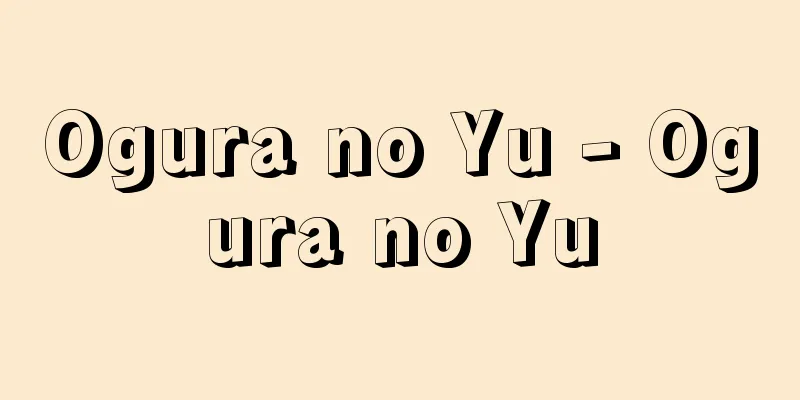Kokin Wakashu - Collection of ancient and modern Japanese poems

|
This is the first imperially commissioned anthology of waka poetry, compiled in the early Heian period. It is also called the Kokinshu for short. [Hideo Suzuki] Editor and EstablishmentBy imperial command of Emperor Daigo, Ki no Tsurayuki, Ki no Tomonori, Oshikouchin no Mitsune, and Mibu no Tadamine were in charge of compiling the book. It was probably completed in 905 (5th year of Engi). However, there is also a theory that this is the year that the emperor issued the order to compile it, so this is not certain. [Hideo Suzuki] compositionThe number of poems is 1,100. However, at the end of the book there are 11 "sumikechiuta" (poems that have been erased with ink so that the original state can be seen). The following categories (categories based on the content of the poems) are arranged in all 20 volumes. Spring Volumes 1 and 2 (2 volumes), Summer Volumes 1 and 2, Autumn Volumes 1 and 2, Winter Volumes, Congratulations (songs praising and celebrating old age, etc.), Separation (mainly farewell songs for officials transferring to new posts in the provinces), Travels (mainly songs about officials traveling), Names of Things (songs that use the names of things as hidden themes), Love Volumes 1-5 (5 volumes), Lamentations (songs mourning the death of people), Miscellaneous Volumes 1 and 2 (mainly songs lamenting old age and impermanence), Zattai (a collection of long poems, tanka, and humorous poems (humorous poems), Ooutadokoro no Miuta, and other ritual poems. Judging from the volume, the majority of the poems are about nature during the four seasons and love. Within each section, the poems are arranged in an orderly fashion, with a chronological progression and various correspondences. This method of construction as a collection of poems also became the model for later collections of poems. [Hideo Suzuki] Kana-jo and Mana-joThis collection is accompanied by a Kana Preface written in Kana prose by Ki no Tsurayuki, and a Mana Preface written in Chinese by Ki no Yoshimochi. The prevailing view is that the Kana Preface was written first, and then later adapted into Chinese. Although there are differences in the order of description and details, the contents of the two prefaces are almost identical, and they touch on the essence and origin of waka poetry, the Six Means (a classification of poetry techniques), a critique of the Six Immortal Poets, and the process of compiling the collection. This also had a major impact on later generations as a theory of waka poetry. [Hideo Suzuki] PoetsThe poems included in this collection can be divided into three periods: (1) the period when there were no readers, (2) the period when the Six Immortal Poets were active, and (3) the period when the composers were active. (1) This period is from the end of the Nara period to the next era of the Six Immortal Poets. Most of the poems that are considered to be of unknown authorship fall into this category. However, some of the poems with unknown authorship are thought to be deliberate attempts to conceal the author's name, so not all of them are from this period. In general, the style of the Manyoshu can be seen in the poems from this period. There are many love poems, and quite a few poems use pillow words and introductory words from the previous era. (2) The period from the Seiwa era to the Koko era (858-886). This was the time when the so-called Six Immortal Poets, Sojo Henjo (Hensho), Ariwara no Narihira, Ono no Komachi, Otomo no Kuronushi, So Kisen, and Funya no Yasuhide, were active, but only three of them actually left behind many excellent poems. Others included Ono no Takamura, Ariwara no Yukihira (Narihira's half-brother), Minamoto no Toru, and, somewhat later, Oe no Chisato, Fujiwara no Toshiyuki, and Sugawara no Michizane. This was the period when the Kokinshu period really began, and it was also around this time that poetry contests started. In terms of expression, techniques such as engo (linked words), kakekotoba (entrope), and mitate (metaphoric expressions) were used, showing a novel style of poetry. (3) During the reign of Emperor Uda and Emperor Daigo (887-930), in addition to the four editors mentioned above, other poets who were active in the country included Ise (a female poet), Sosei Hoshi, Kiyohara Fukayabu, Sakanoue No Korenori, and Fujiwara Kanesuke. During this time, not only poetry contests but also folding screen poems became popular, and the importance of waka poetry in court society increased significantly. This was the period when the style of the Kokinshu was perfected. If we count the number of poems included in the Kokinshu by poet, the order is Tsurayuki with 102, Munetsune with 60, Tomonori with 46, Sosei with 36, Narihira with 30, Tadamine with 36, and Ise with 22. [Hideo Suzuki] The Kokinshu Period and the Character of Waka PoetryThe practice of composing waka poetry did not die out after the publication of the Manyoshu; although the practice of composing poetry in formal settings declined, it was still exchanged in private relationships. However, by the mid-9th century, Chinese poetry and prose, which had been popular in aristocratic society, especially among male bureaucrats, began to decline, and momentum began to emerge for the revival of waka poetry. This was the advent of the aforementioned Six Immortal Poets period. This roughly corresponds to the time when the momentum for reorganizing the Ritsuryo Code, which had been the backdrop for the rise of Chinese poetry and prose, began to wane, and the regent system by the Fujiwara clan began. Fujiwara no Yoshifusa and Mototsune, who were the bearers of the early regent system, sent their own daughters, such as Akira Keiko (Yoshifusa's daughter, who became the consort of Emperor Montoku and gave birth to the future Emperor Seiwa) and Takako (Mototsune's sister, who became the consort of Emperor Seiwa and gave birth to the future Emperor Yozei), to be empresses one after another, and they came to seize real political power by using their blood ties to the imperial family as a middleman. As a result, the harem, the group of empresses, suddenly became an important place both politically and culturally. In this place where the imperial family and aristocrats interacted, waka poetry took on a social character and was actively composed. While Chinese poetry was originally limited to male bureaucrats, waka poetry is a form of poetry that can be composed by both men and women. The sociable nature of waka poetry led to it playing a role in social interactions between people as a form of greeting and correspondence, and it also gave rise to poetry contests in which people would split into two groups and compete to see who could write the best poem, as well as folding screen poems that decorated the rooms of the imperial court and the aristocracy. On the other hand, it is natural that waka from this period also attempted to express one's own feelings, as is the nature of lyric poetry. In particular, in a society that tended to become closed off due to the calculations of the prosperity of the regent family, waka attempted to incorporate the feelings of individuals who tended to be isolated as one aspect. Therefore, waka from this period had a dual nature, in that on the one hand, they communicated with others through indulging in a world of aristocratic refinement and beauty, while on the other hand, they looked at their own loneliness that was incompatible with others. For example, in the poem "Hana no iro wa furinikerinai tazura ni waga shinose ni furu nagame seshima ni" (The colors of the flowers fade away, I look at my own life as if it were a splendid sight), an expression that expresses the melancholy of one's own life in an aesthetic heart that regrets the falling of cherry blossoms. "The flowers will fall without a trace of tranquility on a spring day with the light of the sun shining down on them" (Ki no Tomonori) is an expression that captures the indescribable gloom in the midst of the full bloom of spring. In this way, the tense poetic quality that attempts to unify the duality of cooperation and solitude can be said to be the greatest characteristic of the Kokinshu. [Hideo Suzuki] Poetry style and expression in the KokinshuFrom the characteristics of waka poetry as mentioned above, the characteristic of its expression is that things are not written as they are, but are reconstructed within the framework of the typical aesthetic sense common to that era. Since it reconstructs actual things, the process is intellectual, and the world that is created is conceptual. In order to ensure such expression, in addition to the pillow words and jokotoba that have been used since the previous era, new expression techniques such as kakekotoba, engo, mitate, anthropomorphism, and utamakura were created. These allow complex contexts to be constructed while still giving shape to clear images. This conceptual reconstruction through intellectual action has produced poems with a style that is completely different from the expressions in the previous Man'yoshu. According to the theory of the essence of waka poetry in the "Kana Jo," it is written that "waka poetry (yamauta) is made from the seed of the human heart and has become all kinds of words." Waka expressions are analyzed into two elements, "heart" and "words," and the two are considered to be on different levels. This is a concept called "heart dualism," which says that the heart does not become words as it is, and that words do not necessarily convey the heart as it is. The above-mentioned technique of expression was thought up because the heart can only be contained in words through creative expression. For example, "When I think of myself as a withered field, I will wait for spring even if it burns" (Ise) is a pun on the words "omoi" ( thoughts ) and "hi" (fire), and "moe" (burning) is related to the word. The poet compares his desolate body to a withered field, and if that were really the case, the hopeful spring would come after the wildfire had burned, but he has no hope for it at all, creating a desolate mental landscape. "The wind that has scattered the cherry blossoms has left waves in the waterless sky" (Kino no Tsurayuki) likens the petals that continue to dance in the air even after the wind has blown them away to waves in the waterless sky. This effectively expresses the emptiness that follows the passing of splendid time. The Kokinshu also contains many expressions that incorporate the passage of time. While the poems in the Manyoshu generally capture human emotions in a moment, here we see a method of looking back on life history. This often even awakens a narrative interest. For example, there is an expression in Mibu Tadamine's poem, "Nothing is more sad than the dawn, when we part ways at dawn" that seems to regulate the present. [Hideo Suzuki] ImpactThe Kokinshu not only played a normative role for later imperial waka poetry, but also had a great influence on narrative literature through its use of verse and lyricism. It was respected by medieval poets such as Fujiwara no Shunzei and Teika, and their mysterious and profound style of poetry is thought to have been achieved on the basis of the Kokinshu. In the early modern period, the Keien school of Kagawa Kageki praised the Kokinshu. In the modern era, Masaoka Shiki of the Meiji period harshly criticized the conceptual style of the Kokinshu in order to modernize poetry, but its value is now being reevaluated. [Hideo Suzuki] Various booksThe most widely circulated versions today are those copied by Fujiwara no Teika, including (1) the Joō 2nd year version (handed down by the Nijō family), (2) the Karoku 2nd year version (handed down by the Reizei family), and (3) the Date family version. Others include the Gen'ei version, the oldest surviving complete version, and the Shūnenari version. In addition, there are about 40 fragments that have been handed down as ancient excerpts. [Hideo Suzuki] "Commentary on the Kokin Wakashu, volumes 1 and 2, by Kubota Utsubo (1935, 1937, Tokyodo)" ▽ "Complete Commentary on the Kokin Wakashu, volumes 1 and 2, revised edition , by Takeoka Masao (1981, Ubunshoin)" ▽ "Japanese Classical Literature Series 8: Kokin Wakashu , edited by Saeki Baitomo (1958, Iwanami Shoten)" ▽ "Complete Collection of Japanese Classical Literature 7: Kokin Wakashu, edited and translated by Ozawa Masao (1971, Shogakukan)" ▽ "Complete Translation of Japanese Classics 9: Kokin Wakashu, edited and translated by Ozawa Masao et al. (1983, Shogakukan)" ▽ "Shincho Collection of Japanese Classics: Kokin Wakashu, edited and translated by Okumura Tsuneya (1978, Shinchosha)" ▽ "Kokin Wakashu" (Edited by Kubota Shoichiro, Kadokawa Bunko / Translated and annotated by Katagiri Yoichi, Soeisha, Full bilingual Japanese Classics Shinsho / Edited by Saeki Baitomo, Iwanami Bunko / Translated and annotated by Komachiya Teruhiko, Obunsha Bunko / Edited and annotated by Kusogami Noboru, 4 volumes, Kodansha Academic Library)" ▽ "The World of Kokinshu, by Ozawa Masao (1980, Hanawa Shobo)" ▽ "Study on the Structure of Kokinshu, by Matsuda Takeo (1980, Kazama Shobo)" ▽ "Introduction to Kokin Wakashu, by Fujihira Haruo et al. (Yuhikaku Shinsho)" ▽ "Selection of Excellent Poems from the Court, by Akiyama Ken et al. (1982, Shogaku Tosho)" [References] | | |Source: Shogakukan Encyclopedia Nipponica About Encyclopedia Nipponica Information | Legend |
|
平安時代初期に成った、最初の勅撰(ちょくせん)和歌集。略して『古今集』ともいう。 [鈴木日出男] 編者・成立醍醐(だいご)天皇の勅命によって、紀貫之(きのつらゆき)、紀友則(とものり)、凡河内躬恒(おおしこうちのみつね)、壬生忠岑(みぶのただみね)が撰者として編集にあたった。成立は延喜(えんぎ)5年(905)か。ただし、これを天皇の編集の命令の下った年とみる説もあり、一定しない。 [鈴木日出男] 構成歌数は1100首。ただし、巻末に11首の墨滅歌(すみけちうた)(もとの状態がわかるように墨で消して削除した歌)を付す。全20巻に、次のような部立(ぶだて)(歌の内容上の部類)を配す。春上下(2巻)、夏、秋上下(2巻)、冬、賀(老齢をたたえ祝う歌など)、離別(官人の地方赴任に際しての送別の歌が中心)、羇旅(きりょ)(官人の旅中の歌が中心)、物名(もののな)(物の名称を隠し題として詠み込んだ歌)、恋1~5(5巻)、哀傷(人の死を悲しむ歌)、雑(ぞう)上下(老齢や無常を嘆く歌が中心)、雑躰(ざったい)(長歌、旋頭歌(せどうか)、誹諧歌(はいかいか)〈滑稽諧謔(こっけいかいぎゃく)味のある歌〉などを集める)、大歌所御歌(おおうたどころのみうた)その他の儀式歌。その分量からいっても、四季の自然の歌と、恋の歌が中心を占めている。それぞれの部立内に、歌々が、時間的な進行と多様な照応関係に秩序だてられながら、整然と配されている。その歌集としての構成法も、後世の歌集の規範とされた。 [鈴木日出男] 仮名序・真名序この集には、紀貫之によって仮名散文で書かれた仮名序(かなじょ)と、紀淑望(よしもち)によって漢文で書かれた真名序(まなじょ)が付されている。通説では、まず仮名序が書かれ、のちにそれが漢文に翻案されたとする見方が有力である。両序の内容は、叙述の順序や細部において差違はあるものの、ほぼ一致しており、和歌の本質、起源、六義(りくぎ)(詠法の分類)、六歌仙評、撰集経緯などに触れている。これは、歌論としても後世に大きな影響を与えた。 [鈴木日出男] 歌人たち所収の歌々を時代別にみると、(1)読人(よみびと)しらずの時代、(2)六歌仙時代、(3)撰者時代の3期に分けられる。 (1)奈良末期から次の六歌仙時代に至るまでの時期で、歌中で読人しらずとされる歌のほとんどがこれにあたる。ただし、読人しらずの歌のなかには、あえて名を隠すための処置とみられる場合も含まれるので、すべてがこの時期とは限らない。おおむねこの時期の歌には、『万葉集』の遺風が感じられる。恋歌が多く、前代以来の枕詞(まくらことば)、序詞(じょことば)を用いた歌が少なくない。 (2)清和(せいわ)朝から光孝(こうこう)朝(858~886)ごろの時代。六歌仙とよばれる僧正遍照(遍昭)(へんじょう)、在原業平(ありわらのなりひら)、小野小町(おののこまち)、大友黒主(おおとものくろぬし)、僧喜撰(きせん)、文屋康秀(ふんやのやすひで)の活躍した時期であるが、実際に多くの優れた歌を残したのは、遍照、業平、小町の3人だけである。ほかに、小野篁(たかむら)、在原行平(ゆきひら)(業平の異母兄)、源融(とおる)、やや遅れて大江千里(おおえのちさと)、藤原敏行(としゆき)、菅原道真(すがわらのみちざね)らがいた。これは古今集時代の本格的に開始する時期にあたり、歌合(うたあわせ)がおこるのもこのころであった。表現にも縁語、掛詞(かけことば)や見立ての技法が駆使され、斬新な歌風が示された。 (3)宇多(うだ)・醍醐朝(887~930)で、前掲の4人の撰者たちのほかにも、伊勢(いせ)(女流歌人)、素性(そせい)法師、清原深養父(ふかやぶ)、坂上是則(さかのうえのこれのり)、藤原兼輔(かねすけ)らが活躍した。このころは、歌合のみならず屏風歌(びょうぶうた)も盛んとなり、宮廷社会における和歌の重要性も一段と高まった。古今集歌風の完成の時期にあたる。 なお、歌人別に『古今集』所収の歌数を数えると、貫之102、躬恒60、友則46、素性36、業平30、忠岑36、伊勢22、の順になる。 [鈴木日出男] 古今集時代と和歌の性格『万葉集』ののちも、和歌を詠むという営み自体絶えたのではなく、晴れがましい場での詠歌こそ衰えたものの、私的な関係では、やはり詠み交わされていた。しかし9世紀なかばに至ると、貴族社会では、それまでとくに男子官僚たちの間で盛んであった漢詩文が衰え、和歌の再興する機運をみせ始めた。前述の六歌仙時代の到来である。これは、漢詩文隆盛の背景にあった律令(りつりょう)再編成の気運が薄れ、藤原氏による摂関制が開始する時期とほぼ対応している。初期摂関制の担い手となった藤原良房(よしふさ)や基経(もとつね)らは、明子(あきらけいこ)(良房の娘、文徳(もんとく)天皇の女御(にょうご)となって後の清和(せいわ)天皇を産んだ)、高子(たかいこ)(基経の妹、清和天皇の女御となって後の陽成(ようぜい)天皇を産んだ)ら自家の子女を次々と天皇の后(きさき)として送り込み、皇室との血縁関係をなかだちとして政治の実権を掌握するようになる。そのために、后たちの集団である後宮(こうきゅう)が政治的にも文化的にもにわかに重要な場となった。皇族や貴族たちも交流しあうその場では、和歌が社交的な性格を帯びながら活発に詠まれるようになる。もとより漢詩が男子官僚に限られるのに対して、和歌は男女の区別なくつくれる詩形である。この和歌の社交的な性格から、人々の交際においても和歌が挨拶(あいさつ)、文通の役割を果たし、左右に分かれて歌の優劣を競う歌合や、宮廷や貴族の室内を飾る屏風歌も行われるようになった。 しかし他面では、この時代の和歌もまた、叙情詩本来の性格として自分自身の感情を表そうとするのは当然である。とくに、摂関家繁栄のための打算から、とかく閉塞(へいそく)的になりがちな社会にあって、和歌は、その孤立しがちな個人の心情を一面として取り込めようとする。したがってこの時代の和歌は、一面では貴族的に洗練された美の世界にふけることを通して他者と交流しながら、一面では他者と相いれない自己の孤心を見つめるという、二重性をもっていた。たとえば、「花の色はうつりにけりないたづらにわが身世にふるながめせしまに」(小野小町)の、桜花の散るのを惜しむ耽美(たんび)の心に自己の生涯の憂愁を言い込めた表現。「ひさかたの光のどけき春の日に静心(しづごころ)なく花の散るらむ」(紀友則)の、春爛漫(らんまん)のなかにえたいの知れぬかげりを感取した表現。このように、協調と孤心の二重性を統一づけようとする緊張的な詩性こそ、『古今集』最大の特徴であるともいえる。 [鈴木日出男] 『古今集』の歌風と表現前記のような和歌の性格からも、その表現の特徴は、物事を事実どおりに詠むのではなく、この時代共通の典型的美意識の枠組みのなかに再構成する点にある。実際の物事を再構成するのであるから、その作用は理知的であり、できあがった世界は観念的である。こうした表現を確保するために、前代以来の枕詞、序詞のほかに、新たに掛詞、縁語、見立て、擬人法、歌枕などの表現技法も生み出された。これらによって、複雑な文脈を構成しながら、しかも鮮明なイメージを形象させている。この理知的な作用による観念的な再構成は、前代の『万葉集』の表現とはまるで相違した歌風の歌々を出来(しゅったい)させた。「仮名序」の和歌本質論によれば「和歌(やまとうた)は、人の心を種として、よろづの言の葉とぞなれりける」とある。和歌表現を〈心〉と〈詞(ことば)〉の2要素に分析して、二つは別次元のものとした。「心詞二元論」とよばれる考え方で、〈心〉がそのまま〈詞〉にはならず、〈詞〉がそのまま〈心〉を伝えるとは限らないとする。〈心〉は表現上のくふうを凝らして、初めて〈詞〉に封じ込められるという点から、前記の表現技法も案出されたとみられる。たとえば、「冬枯れの野辺とわが身を思ひせば燃えても春を待たましものを」(伊勢)は、「思ひ」と「火」の掛詞、それと「燃え」が縁語の関係。自分のうらぶれた身を冬枯れの野辺と見立ててみるが、ほんとうにそうなら野火の燃え過ぎたあとに希望の春もめぐろうが、自分にはまったく期待できないとする、荒寥(こうりょう)たる心象風景となっている。「桜花散りぬる風のなごりには水なき空に波ぞ立ちける」(紀貫之)は、風の吹き散らしたあとも花びらがちらちら空中を舞うさまを、「水なき空に波」が立つと見立てた。それによって、華麗な時の過ぎ去ったあとの空虚さがよく表されている。また『古今集』では、時間の推移を取り込む表現も多い。『万葉集』の歌がおおむね人間の感情を瞬間的にとらえているのに対して、ここには人生史への回顧という方法がみられる。それはしばしば物語的な関心をさえ呼び覚ますことになる。たとえば、「有明のつれなく見えし別れより暁ばかり憂きものはなし」(壬生忠岑)など、恋の別れの過去が現在をも規制しているような表現になっている。 [鈴木日出男] 影響『古今集』は、後の王朝和歌に対して規範的な役割を果たしたのみならず、物語文学にも引き歌や歌ことばなどを通して多大の影響を与えた。藤原俊成(しゅんぜい)・定家(ていか)など中世歌人にも尊重され、彼らの幽玄の歌風もこれを基盤として達成されたとみられる。近世では香川景樹(かがわかげき)の桂園(けいえん)派によって『古今集』が称揚された。近代に入ると、明治期の正岡子規(まさおかしき)が詩歌の近代化のために『古今集』の観念的歌風を激しく罵倒(ばとう)したが、現在ではその価値が再評価されている。 [鈴木日出男] 諸本現在広く流布しているのは、藤原定家筆写の系統で、(1)貞応(じょうおう)二年本(二条家相伝)、(2)嘉禄(かろく)二年本(冷泉(れいぜい)家相伝)、(3)伊達(だて)家本。ほかに完本として現存最古の元永(げんえい)本、俊成本がある。さらに、古筆切(こひつぎれ)として40種ほどの断簡も伝わっている。 [鈴木日出男] 『窪田空穂著『古今和歌集評釈』上下(1935、1937・東京堂)』▽『竹岡正夫著『古今和歌集全評釈』上下・補訂版(1981・右文書院)』▽『佐伯梅友校注『日本古典文学大系8 古今和歌集』(1958・岩波書店)』▽『小沢正夫校注・訳『日本古典文学全集7 古今和歌集』(1971・小学館)』▽『小沢正夫他校注・訳『完訳日本の古典9 古今和歌集』(1983・小学館)』▽『奥村恒哉校注『新潮日本古典集成 古今和歌集』(1978・新潮社)』▽『『古今和歌集』(窪田章一郎校注・角川文庫/片桐洋一訳注・創英社・全対訳日本古典新書/佐伯梅友校注・岩波文庫/小町谷照彦訳注・旺文社文庫/久曽神昇校注・全4巻・講談社学術文庫)』▽『小沢正夫著『古今集の世界』(1980・塙書房)』▽『松田武夫著『古今集の構造に関する研究』(1980・風間書房)』▽『藤平春男他著『古今和歌集入門』(有斐閣新書)』▽『秋山虔他著『王朝秀歌選』(1982・尚学図書)』 [参照項目] | | |出典 小学館 日本大百科全書(ニッポニカ)日本大百科全書(ニッポニカ)について 情報 | 凡例 |
<<: Six volumes of ancient and modern waka poetry
>>: Coquimbo (English spelling)
Recommend
Toggle mechanism - toggle mechanism
Also called a force multiplier. A type of link mec...
Aremonite - Aremonko
...More than 30 kinds of elemental minerals are k...
Poverty God - Binbougami
〘Noun〙① A god that is said to possess people and m...
Religious art
It refers to art created for religious purposes, ...
Enamel device - Enamel device
…When these parallel striations appear on the too...
Direct and indirect taxes
There are various criteria for distinguishing betw...
Zonal structure
A discontinuous banded structure formed by differe...
Horseshoe jellyfish - Kabuto jellyfish
A ctenophore of the family Helmetidae of the class...
Mass (English)
A mass is a heterogeneous group of many people wh...
Wang Wei
A Chinese poet and painter from the Tang Dynasty....
oil
…their chemical compositions are completely diffe...
Simla Conference - Shimla Conference (English name)
A tripartite conference on Tibetan independence he...
Glis glis (English spelling) Glisglis
…It is designated as a national natural monument....
Brachyponera chinensis (large needle ant)
An insect of the family Formicidae in the order Hy...
Kiga forest
1810-1883 A wealthy merchant and pioneer from the...









